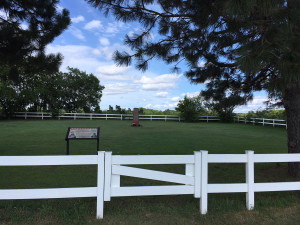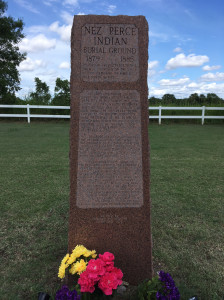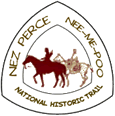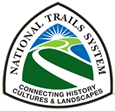Following the Footsteps . . .
The Journey Didn’t End at the Bear’s Paw Battlefield
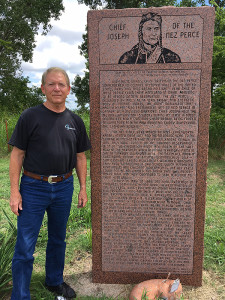
Jim Zimmerman, past President of the NPTF, follows the journey of the captured Nez Perce through Kansas and Oklahoma
My wife and I decided to visit and conduct research on the final resting place of those Nez Perce who passed away during their incarceration near Tonkawa, Oklahoma. Those who were captured at Bear Paw, Montana were incarcerated at Ft. Leavenworth, Kansas for approximately one year. They were later sent south to eventually end up on a reservation in northeast Oklahoma. My research trip from Kentucky first took me to the vicinity of Baxter Springs, Kansas. Baxter Springs is located in the southeast corner of Kansas, and is one of the very few Kansas towns that the famous Route 66 runs through. I actually lived in Baxter Springs as a child. Baxter Springs was the location where the Nez Perce prisoners were unloaded from the train, with the rest of their journey to take place by foot and wagon. Their eventual destination took the Nez Perce to the area of Quapaw, Oklahoma. Again, as strange as it might seem, my uncle was born in Quapaw, Oklahoma. I have often wondered how I might be connected spiritually to the people and events of 1877. Quapaw, Oklahoma is in many ways like central Kentucky. Moderate heat can be miserable when combined with high humidity. This surely was the case with the Nez Perce whose physical condition was more adapted to the cooler, less humid conditions of the Northwest. The Nez Perce were located on the west side of Spring River just a couple of miles south of the Kansas state line, and almost due east of Quapaw, Oklahoma. This area has been subject to flooding, and the interpretative panels that document the history of the Nez Perce in this area have taken a beating. From Quapaw, I set my sights on Tonkawa, Oklahoma. Chief Joseph and the remaining incarcerated Nez Perce would eventually be relocated to present day Tonkawa, which is a few miles west of Ponca City, Oklahoma. This was the location of Fort Oakland which no longer exist. My first goal was to find the Tonkawa area monument recognizing the presence of Chief Joseph and the Nez Perce people. I eventually found this monument on the east-bound side of U.S. Highway 60 about a quarter mile east of the South Main Street interchange for Tonkawa City. I was grateful to find the monument in good condition. It was obvious that the monument had been visited over time by a number of individuals, which was evident by the number of mementoes left at the base of the monument. My next goal was to find the Nez Perce cemetery. I found that if you drive east from the Highway 60 monument to the next intersection (which is really close) and turn right, you are headed in the right direction. This road is listed as Allen Drive or Route 1505. Once on Allen Drive, I drove south for just over a mile. I found the Nez Perce cemetery on the left side of the road with virtually no parking spaces available. I actually parked my vehicle at a small company parking lot and walked to the cemetery. On my way, a Tonkawa Tribe law enforcement officer stopped and inquired as to the purpose of being on the road. After my explanation, he expressed his appreciation for my interest and my being there to honor the Nez Perce who rested there. What I found was probably the most manicured and best maintained cemetery I had ever encountered. The resting place of the Nez Perce is enclosed by a white board fence that was in excellent condition. The grass was cut and the area around the fence post was trimmed . The interpretative panel that told the story of the Nez Perce that lived in the area was located inside the fence line. It too was in excellent condition. Within the cemetery grounds is a seven-foot-high pink granite memorial stone that was erected by Henry Allen and the Tonkawa Tribe. Henry Allen had served as the Tonkawa Tribal Chairman for 18 years. The monument is inscribed with the story of the suffering that the Nez Perce people endured. We can be thankful that this hallowed ground exists and continues to be respectfully maintained. My concern that the cemetery would be in bad shape was not realized. Thanks to the Tonkawa Tribe authorities and people, the resting place of the Nez Perce is an inspirational location that honors the Nez Perce with dignity. JZ
Jim Zimmerman photos©2017
